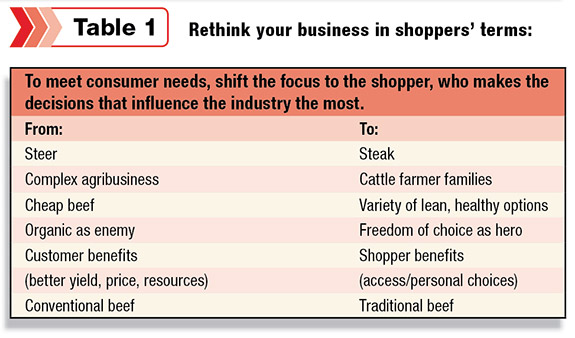To gain a better understanding of how these groups and messages influence the primary household shopper, Merck Animal Health commissioned two leading research firms to analyze consumers’ perceptions, motivations and behaviors toward beef.

The qualitative research
Studies show that women purchase or influence the purchase of nearly 85 percent of everything sold in the U.S. For this reason, Merck Animal Health enlisted Just Ask a Woman, a leading women’s marketing company, to conduct a study of qualitative research. The study included nearly 100 in-depth interviews of both male and female primary shoppers.
From results of this initial study, Merck Animal Health confirmed price and value are important, but consumers don’t want to feel like they are getting inferior or cheap products.
Likewise, consumers value choice and want to feel they are in control of determining what they buy for their family. Consumers recognized they have been eating and enjoying beef for a long time and typically have strong emotional memories associated with their beef-eating occasions.
To them, the phrase “traditional beef” represented trust, safety and freedom of choice to the consumer.
The quantitative research
The Hartman Group, a leader in identifying food culture trends, was enlisted to conduct quantitative research for the study. This included a national survey of more than 2,800 beef shoppers analyzing consumers’ attitudes about food safety, different types of food, perception of beef production methods and food messaging.
From the results of this survey, we learned the majority of consumers eat beef and are, in fact, comfortable with the quality and safety of traditional beef. “Traditional beef” was scored high as a message that aligns with shared beliefs and values and resonates strongly with consumers.
Additionally, many consumers wanted to hear messages about their beef from the people who produce it and have those messages reinforced by regulators overseeing beef safety and quality as well as the scientific community.
Below is information about the key takeaways from the studies, along with messaging points to remember when sharing the beef story.
Traditional beef versus conventional beef
A “traditional beef” message evokes positive responses from consumers and is a more favorable alternative to “conventional beef.” It also provides a positive point of entry to discuss beef and beef production with consumers.
As advocates for beef, we should lead conversations with messages about our farming values and remember that most consumers have fond memories of traditional beef practices.
Most consumers even remember growing up with beef as a favorite choice for family occasions. As most consumers respect the role of cattle farmer families, remember to discuss the generations who have evolved best practices over decades to deliver the best-quality beef to today’s consumer.

Mom still controls the grocery list
The role of America’s most important shopper, Mom, should not be underestimated.
She is the family’s most trusted gatekeeper and wants to maintain control of the choices she makes for her family.
When discussing beef with a mom, support her right to choose what she serves to her family.
Also remember to discuss family farmers who work hard to grow the same safe, high-quality beef for their own families. Moms want the option to choose, and we should support this freedom of choice.
Values backed by a trustworthy voice
Consumers want to know that farmers and ranchers share the same values as they do and also care about the animals they raise, the end product they produce and the consumer.
Additionally, consumers want to hear from someone they believe to be credible, such as cattle-farming families and others involved in supplying beef, as well as people who are highly educated and have a scientific background in the subject matter.
For this reason, we should be sure we are providing accurate and educational information about the beef production process and proven safety. We can also engage in ways that foster positive word-of-mouth communications about beef, such as starting conversations while waiting in line at the grocery store.
Other shopper insights
Even with all of the news coverage about natural and organic beef products, most consumers still purchase traditional beef for their families.
Yet there are signs that media and advocacy groups have introduced conflict into these conversations, with more than half of consumers agreeing that making food choices today is hard because there is someone dictating what’s safe, ethical or sustainable.
As messages become muddled, it is our responsibility to have accurate, positive conversations about beef. If we aren’t providing information about the safe, high-quality beef produced by our U.S. cattle farmer families, consumers will get it from another source.
Consumers thirst for knowledge and it is our privilege to share the story of beef with individuals across the country. ![]()

Jennie M. Hodgen
Technical Services Specialist
Merck Animal Health








